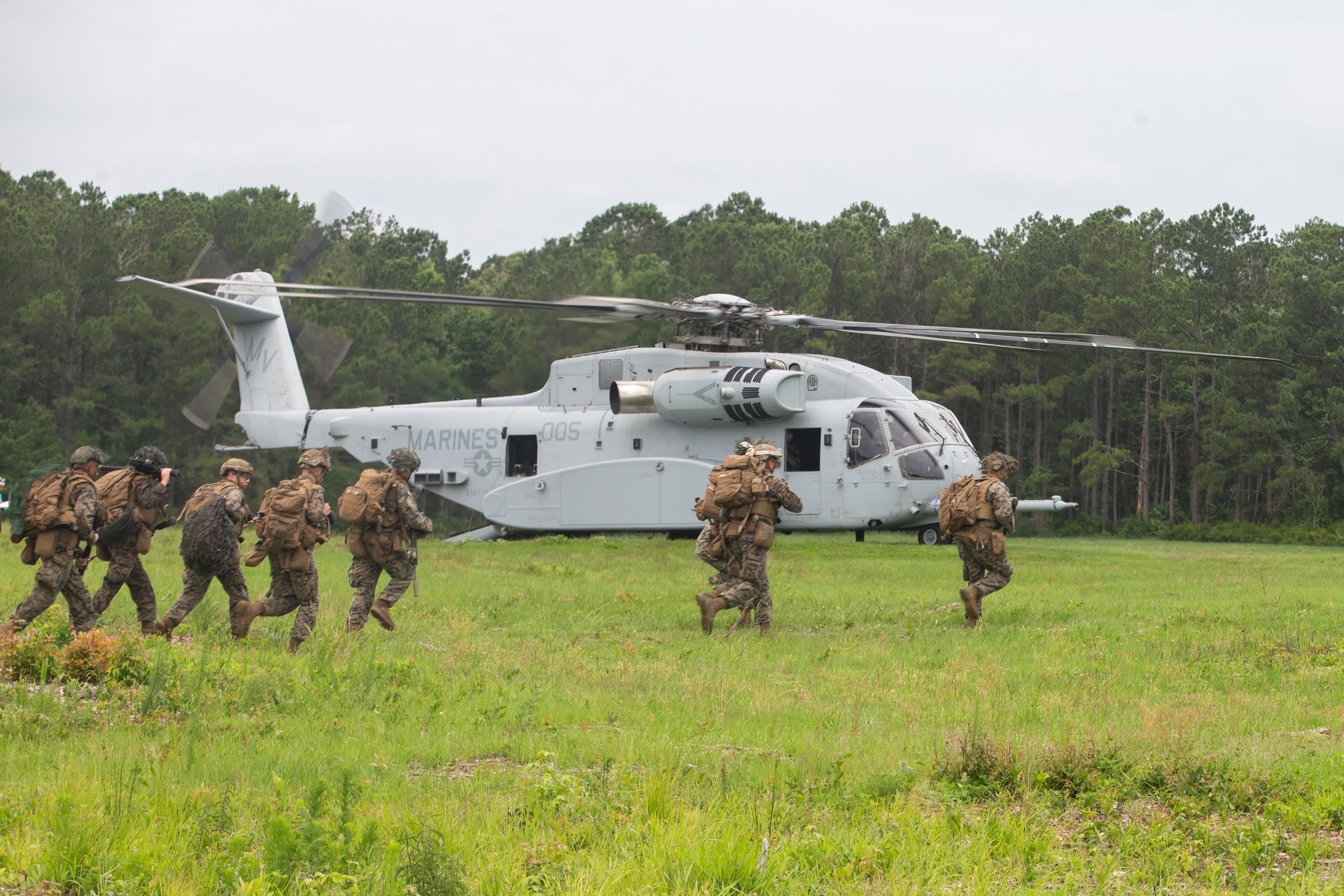NATIONAL HARBOR, Md. — The U.S. Marine Corps is on its way to declaring initial operational capability for its CH-53K King Stallion heavy lift helicopter this year and moving into full-rate production in 2023, the program manager told reporters April 5.
Col. Jack Perrin said the first CH-53K operational squadron, Marine Heavy Helicopter Squadron (HMH) 461, received its first two helicopters in January and will grow to four aircraft later this month.
The helicopter has completed all its initial operational test and evaluation test vignettes, Perrin and Sikorsky program manager Bill Falk announced Tuesday, and Perrin said the remaining work to declare IOC should be wrapped up “in the next several months.”
According to a Sikorsky news release, IOC can be declared when the first operational squadron has received four helicopters; when its personnel are properly trained and qualified on the aircraft; and when training, spare parts and maintenance capacity are mature enough the squadron could deploy if needed.
Perrin said HMH-461 will have the four helicopters in a matter of weeks, leaving the Marine Corps to verify the training and logistics before declaring the program ready for operations.
Tests have already proven the CH-53K can meet all its requirements for carrying heavy loads the proper distance and in sufficiently challenging environmental conditions. Tests have also included daytime and nighttime aerial refuelings, more than 350 landings on a ship at sea and more.
Perrin said this ability to carry vehicles as large as the Joint Light Tactical Vehicle, large pallets of supplies and 30 passengers would be an important aspect of sustaining the Marine Corps as it begins to conduct distributed operations across wider operating areas, through concepts like Distributed Maritime Operations and Expeditionary Advanced Base Operations.
“When you have those distributed operations, when you have those small teams out there doing the mission for the Marine Corps, you need to supply them — supply them with anything and everything, whether it’s ammunition, it’s resupplying them with other troops, resupplying them with food, water — whatever it is, you’re going to need that vertical lift to go to those island chains. The 53K is going to be the backbone of that,” he said at the Navy League’s annual Sea Air Space conference.

Once the Marine Corps declares IOC in the coming months, the next focus will be working with Sikorsky to formally move into full-rate production.
“We’re actually very well on our way to that full-rate production decision, and I expect the team to have completed all those requirements and be able to execute that in fiscal year ‘23,” the colonel said.
Full operational capability would come in 2029, when enough helicopters have been delivered to support four 16-aircraft squadrons on the West Coast, a larger 20-helo squadron on the East Coast, and the fleet replacement squadron that trains new pilots fresh out of flight school.
Until then, the legacy CH-53E Super Stallion and the Navy’s MH-53E Sea Dragon will have to maintain their readiness to keep fulfilling the heavy lift mission.
Perrin told Defense News during the discussion the legacy aircraft are expected to continue meeting their mission requirements through the end of their planned service life, when they’d be replaced by new King Stallions coming off Sikorsky’s Connecticut production line. The Marines and Sikorsky are “on plan and on course to have a smooth transition of heavy lift from the 53E to the 53K.”
“I do not see any major risk associated with that at this time,” he added.
Falk said during the discussion the first two helicopters have been delivered — one in October and one last month — and seven are in or nearing final assembly. A total of 46 are on contract now, including 42 for the Marines and four for Israel, and 14 more are on contract for long lead time materials.
Four helos will arrive in 2022, Falk said, with eight planned for 2023 and then 16 a year slated for 2024 and beyond once the company goes into full-rate production. The Marine Corps’ program of record is 200 helicopters.
Falk told Defense News Sikorsky will have to set up three parallel production lines to meet the Marines’ needs, but the third line will not be at full capacity. As a result, the company will be seeking additional foreign sales to fill out this line.
Israel has four in production and four more on contract for long lead materials, with the potential to increase their buy. Germany has decided to pursue its heavy lift helicopter replacement program through a foreign military sale and is in touch with U.S. State and Defense department offices about the CH-53K program as a potential solution, Perrin said.
Megan Eckstein is the naval warfare reporter at Defense News. She has covered military news since 2009, with a focus on U.S. Navy and Marine Corps operations, acquisition programs and budgets. She has reported from four geographic fleets and is happiest when she’s filing stories from a ship. Megan is a University of Maryland alumna.




